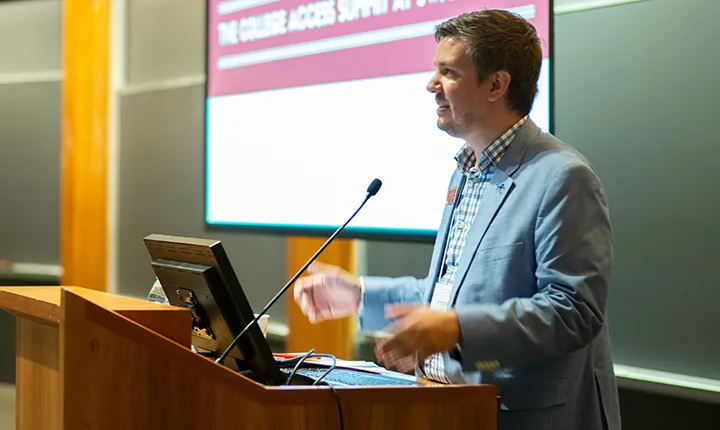Associate Dean of Admissions Andrew Moe on Helping Low-Income Students Beat the "Summer Melt"

Associate Dean of Admissions and Director of Access Andrew Moe
The Hechinger Report: Ensuring that admitted first-generation, low-income students show up to campus
This year, more than 20 million students will be enrolled in degree-granting postsecondary institutions in America. While students with funding and family support are likely to feel typical jitters and nervousness, there’s a whole different level of stress for first-generation and low-income college students.
Some of them won’t show up.
For many of these students, getting through high school, applying to college and gaining acceptance have already been monumental challenges.
The summer between graduation and arriving on campus also includes several additional obstacles. Has my financial aid award been posted? Have I accepted my student loans correctly? How am I going to get to my out-of-state campus? How do I submit my immunization records? Without support from folks who have been to college, the list can be daunting.
It can even derail a student from enrolling.
The phenomenon in which students who are planning to enroll in college but don’t show up in the fall is known as “summer melt.” The students want to attend, but for them, it seems too challenging and overwhelming. Summer melt can be seen at much higher rates in first-generation, low-income students. It’s our institutional responsibility to help those we have admitted and enrolled navigate this process and set of expectations.
...
At Swarthmore College, 22 percent of our incoming first-year class this fall is composed of first-generation college students. Approximately 23 percent of incoming students are eligible for federal Pell Grants. As a result, it’s important for us to think about all aspects of the student experience through the lens of this population. This includes ensuring that student jobs go first to those who truly need them, moving students onto campus who might not have family members in tow, selecting resident assistants who reflect the student body, and being thoughtful in planning our orientation program.
...
Academic pressure affects all students, including—especially—first-generation, low-income students. At Swarthmore, we employ a pass/fail grading system for all students during the first semester of freshman year, which helps students acclimate to campus without worrying about grades. Instead, they can get to know their roommates, make friends, join student organizations, and settle into college life.
Another initiative that helps remove some of the stigma felt by low-income students is our cash-free campus. Even with colleges that meet 100 percent of demonstrated financial need, the hidden costs of higher education can add up. A student may have to pay to get into a film screening or basketball game. At Swarthmore, students use their ID cards to partake in movie nights or special lectures, to print materials, and to do laundry. Including an annual activity fee in a student’s cost of attendance—and, therefore, financial-aid package—is a simple fix that helps all students and reduces the need to pay for things out of pocket.
...
We have more work to do. Swarthmore must collaborate, not compete, with peer institutions to find better solutions to more problems. We must work with school counselors, college advisers, and parents and guardians (in languages besides English) to get students to and through college. Most of all, we must ask our students what they need to succeed.
While we certainly can’t solve all of the challenges faced by first-generation, low-income students when they come to campus, we’re working very hard at Swarthmore to make our student body better reflect the true character and fabric of the world. A global outlook, a diversity of perspectives, and the development of leaders for the common good are at the foundation of who we are as a college. Programs that make all of our students feel comfortable and help them succeed, both within and beyond the classroom, work toward this.



